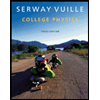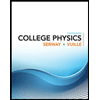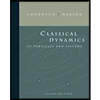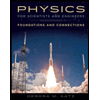A boy throws a steel ball straight up. Consider the motion of the ball only after it has left the boy's hand but before it touches the ground, and assume that forces exerted by the air are negligible. For these conditions, the force(s) acting on the ball is (are):
A boy throws a steel ball straight up. Consider the motion of the ball only after it has left the boy's hand but before it touches the ground, and assume that forces exerted by the air are negligible. For these conditions, the force(s) acting on the ball is (are):
College Physics
10th Edition
ISBN:9781285737027
Author:Raymond A. Serway, Chris Vuille
Publisher:Raymond A. Serway, Chris Vuille
Chapter7: Rotational Motion And The Law Of Gravity
Section7.5: Newtonian Gravitation
Problem 7.8QQ: A ball is falling toward the ground. Which of the following statements are false? (a) The force that...
Related questions
Question
A boy throws a steel ball straight up. Consider the motion of the ball only after it has left the boy's hand but before it touches the ground, and assume that forces exerted by the air are negligible. For these conditions, the force(s) acting on the ball is (are):
Expert Solution
This question has been solved!
Explore an expertly crafted, step-by-step solution for a thorough understanding of key concepts.
This is a popular solution!
Step 1
VIEWTrending now
This is a popular solution!
Step by step
Solved in 1 steps

Knowledge Booster
Learn more about
Need a deep-dive on the concept behind this application? Look no further. Learn more about this topic, physics and related others by exploring similar questions and additional content below.Recommended textbooks for you

College Physics
Physics
ISBN:
9781285737027
Author:
Raymond A. Serway, Chris Vuille
Publisher:
Cengage Learning

College Physics
Physics
ISBN:
9781305952300
Author:
Raymond A. Serway, Chris Vuille
Publisher:
Cengage Learning

Principles of Physics: A Calculus-Based Text
Physics
ISBN:
9781133104261
Author:
Raymond A. Serway, John W. Jewett
Publisher:
Cengage Learning

College Physics
Physics
ISBN:
9781285737027
Author:
Raymond A. Serway, Chris Vuille
Publisher:
Cengage Learning

College Physics
Physics
ISBN:
9781305952300
Author:
Raymond A. Serway, Chris Vuille
Publisher:
Cengage Learning

Principles of Physics: A Calculus-Based Text
Physics
ISBN:
9781133104261
Author:
Raymond A. Serway, John W. Jewett
Publisher:
Cengage Learning

Classical Dynamics of Particles and Systems
Physics
ISBN:
9780534408961
Author:
Stephen T. Thornton, Jerry B. Marion
Publisher:
Cengage Learning

Physics for Scientists and Engineers: Foundations…
Physics
ISBN:
9781133939146
Author:
Katz, Debora M.
Publisher:
Cengage Learning